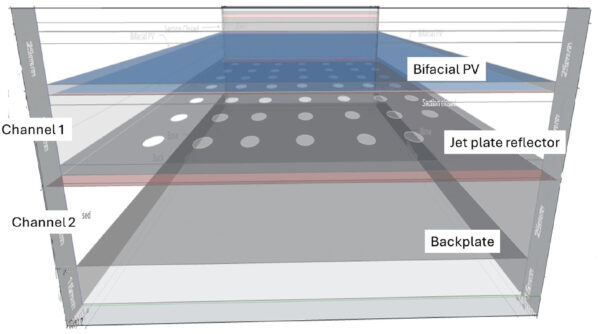An international research group led by scientists from Scotland's University of Strathclyde conducted an energy, economic, and environmental analysis of BPVT solar panels using jet impingement for cooling. The team developed a numerical model of the system and built a real-life experimental setup to validate it. They achieved a thermal efficiency of 62.28%, while electrical efficiency peaked at 11.22%.
“This study introduces dual-functional jet plate reflectors designed to provide cooling and increase light absorption on the rear side of the BPV module,” the group explained. “Besides that, using the bifacial module can increase electrical efficiency due to its ability to capture sunlight from both the front and rear sides. These modules are more effective in capturing diffuse radiation (scattered sunlight on cloudy days), allowing them to perform better in variable weather conditions than conventional PV modules.”
The team's numerical model was set up on MATLAB, using 1-D heat flow in a steady state. The model assumes it comprises a bifacial PV panel, an insulated backplate, and a jet plate, with one air channel between the jet plate and the PV and another one between the backplate and the jet. It calculates temperatures and efficiencies using factors such as air mass flow rate, solar irradiance, and jet plate cooling effects.
To validate the model, the academic team built an experimental setup. It uses a 36-hole jet plate reflector,12-cell bifacial PV panel, and airflow channels with a length of 0.025 meters. The packing factor, or the ratio of the area occupied by the solar panels to the total area available for installation, was tested at 0.22, 0.33, and 0.66, while the air mass flow rate was in the range of 0.014kg/s to 0.035 kg/s.

Image: University of Strathclyde, Case Studies in Thermal Engineering, CC BY 4.0
“The surrounding area's air initially enters the bottom channel before passing through the jet plate reflector's holes and entering the top channel. The bottom of the bifacial solar panel is struck by air that emerges from the upper channel. The bifacial solar panel and the surrounding air exchange heat,” the group said. “At the top of the testing portion, six rows of 48 halogen lamps each serve as solar simulators to mimic sun irradiance, according to the collector measurements. Each lamp has a 500 W heat flux and measures 118 mm in length.”
Comparing the results of the setup and the model, the latter was validated with accuracy rates of 94.53% for thermal efficiency and 98.91% for electrical efficiency. The group was able to input different measurements in the numerical model, finding that the systems operate within the temperature and electrical efficiency ranges of 304.39 K to 339.54 K and 9.39% to 11.22%, respectively.
“Conversely, thermal efficiencies directly correlate with air velocity and solar irradiation. The system's thermal efficiency and output air temperature range from 33.86% to 62.28% and 302.07 K to 318.75 K, respectively,” the scientists added. “Furthermore, the PV temperature has an inverse relationship with mass flow rate and a direct relationship with solar irradiation. On the other hand, there is an inverse link between solar irradiation and mass flow rate and electrical efficiency.”
The researchers have also conducted an economic and environmental analysis of the system. They assumed a 20-year lifespan for the BPVT, with eight hours of operation per day.
“Regarding cost-benefit ratio (CBR), the variations range from 0.1363 to 9.3445, with an average of two,” they concluded. “Furthermore, by using BPVT with jet impingement to produce electricity instead of fossil fuels, it is possible to decrease yearly carbon dioxide emissions by about 1.61 tons and save MYR 93.51 ($21.31) annually.”
They presented their results in “Energy-economic-environmental analysis of bifacial photovoltaic thermal (BPVT) solar air collector with jet impingement,” which was recently published in Case Studies in Thermal Engineering.
The research team included scientists from Scotland's University of Strathclyde, Malaysia's Universiti Kebangsaan Malaysia, and Universiti Teknologi PETRONAS. It also comprised researchers from Russia's South Ural State University, Iran's Islamic Azad University, and Indonesia's National Research and Innovation Agency, Widyatama University, and Universitas Singaperbangsa Karawang.
This content is protected by copyright and may not be reused. If you want to cooperate with us and would like to reuse some of our content, please contact: editors@pv-magazine.com.



By submitting this form you agree to pv magazine using your data for the purposes of publishing your comment.
Your personal data will only be disclosed or otherwise transmitted to third parties for the purposes of spam filtering or if this is necessary for technical maintenance of the website. Any other transfer to third parties will not take place unless this is justified on the basis of applicable data protection regulations or if pv magazine is legally obliged to do so.
You may revoke this consent at any time with effect for the future, in which case your personal data will be deleted immediately. Otherwise, your data will be deleted if pv magazine has processed your request or the purpose of data storage is fulfilled.
Further information on data privacy can be found in our Data Protection Policy.